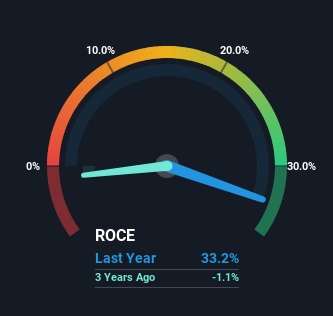Why The 33% Return On Capital At Jupiter Wagons (NSE:JWL) Should Have Your Attention
What trends should we look for it we want to identify stocks that can multiply in value over the long term? In a perfect world, we'd like to see a company investing more capital into its business and ideally the returns earned from that capital are also increasing. If you see this, it typically means it's a company with a great business model and plenty of profitable reinvestment opportunities. Speaking of which, we noticed some great changes in Jupiter Wagons' (NSE:JWL) returns on capital, so let's have a look.
Return On Capital Employed (ROCE): What Is It?
For those that aren't sure what ROCE is, it measures the amount of pre-tax profits a company can generate from the capital employed in its business. To calculate this metric for Jupiter Wagons, this is the formula:
Return on Capital Employed = Earnings Before Interest and Tax (EBIT) ÷ (Total Assets - Current Liabilities)
0.33 = ₹3.6b ÷ (₹21b - ₹9.8b) (Based on the trailing twelve months to September 2023).
So, Jupiter Wagons has an ROCE of 33%. In absolute terms that's a great return and it's even better than the Machinery industry average of 17%.
See our latest analysis for Jupiter Wagons

In the above chart we have measured Jupiter Wagons' prior ROCE against its prior performance, but the future is arguably more important. If you'd like, you can check out the forecasts from the analysts covering Jupiter Wagons here for free.
What Can We Tell From Jupiter Wagons' ROCE Trend?
The fact that Jupiter Wagons is now generating some pre-tax profits from its prior investments is very encouraging. About four years ago the company was generating losses but things have turned around because it's now earning 33% on its capital. And unsurprisingly, like most companies trying to break into the black, Jupiter Wagons is utilizing 621% more capital than it was four years ago. This can tell us that the company has plenty of reinvestment opportunities that are able to generate higher returns.
For the record though, there was a noticeable increase in the company's current liabilities over the period, so we would attribute some of the ROCE growth to that. Essentially the business now has suppliers or short-term creditors funding about 47% of its operations, which isn't ideal. And with current liabilities at those levels, that's pretty high.
Our Take On Jupiter Wagons' ROCE
Overall, Jupiter Wagons gets a big tick from us thanks in most part to the fact that it is now profitable and is reinvesting in its business. Since the stock has returned a staggering 2,125% to shareholders over the last five years, it looks like investors are recognizing these changes. In light of that, we think it's worth looking further into this stock because if Jupiter Wagons can keep these trends up, it could have a bright future ahead.
If you'd like to know more about Jupiter Wagons, we've spotted 3 warning signs, and 1 of them shouldn't be ignored.
High returns are a key ingredient to strong performance, so check out our free list ofstocks earning high returns on equity with solid balance sheets.
New: Manage All Your Stock Portfolios in One Place
We've created the ultimate portfolio companion for stock investors, and it's free.
• Connect an unlimited number of Portfolios and see your total in one currency
• Be alerted to new Warning Signs or Risks via email or mobile
• Track the Fair Value of your stocks
Have feedback on this article? Concerned about the content? Get in touch with us directly. Alternatively, email editorial-team (at) simplywallst.com.
This article by Simply Wall St is general in nature. We provide commentary based on historical data and analyst forecasts only using an unbiased methodology and our articles are not intended to be financial advice. It does not constitute a recommendation to buy or sell any stock, and does not take account of your objectives, or your financial situation. We aim to bring you long-term focused analysis driven by fundamental data. Note that our analysis may not factor in the latest price-sensitive company announcements or qualitative material. Simply Wall St has no position in any stocks mentioned.
About NSEI:JWL
Jupiter Wagons
Manufactures and sells railway wagons, wagon components, and railway transportation equipment in India and internationally.
Excellent balance sheet with reasonable growth potential.
Similar Companies
Market Insights
Community Narratives




